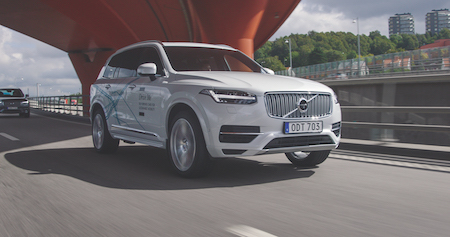What are the different levels of automation?
The most commonly used standard for defining the level of automation is SAE J3016, Taxonomy and Definitions for Terms Related to On-Road Motor Vehicle Automated Driving Systems. This standard defines the levels as 0 to 5. Levels 0 to 2 are driver assistance systems and 3 to 5 are automated systems. 0 is without any kind of assistance system, 1 is longitudinal support (adaptive cruise control), 2 is both lateral and longitudinal support (Pilot Assist systems), 3 (conditionally automated systems) is an automated system where the car monitors and keeps a distance to the car in front and stays in the lane but with the driver as the fall back if anything should go wrong, 4 (Highly automated system) the car takes care of everything (no driver fall back) but going autonomous cannot be everywhere only on certain stretches of the roads or in the cities and 5 (Fully autonomous system) is when a system can be autonomous everywhere.
What level of automation are Volvo cars at?
The 90 Series comes with our Pilot Assist system as standard. This system is a (SAE) level 2 system i.e. the driver is responsible, must supervise and intervene whenever needed. Read more on page 5 in attached file. Also the new Volvo XC60, revealed in Geneva last week, is offered with Pilot Assist (optional). (At the moment there are no cars available to customers with higher level of automation than level 2).
What is the issue with level 3 automation?
We take the safest approach possible to autonomous drive (AD). Therefore we want to make it as safe and easy as possible for our customers. In level 2 the driver is responsible for the monitoring and must be in control at all times. The driver is not allowed to do distracting secondary tasks. For level 4 the car takes care of everything, both the driving, no supervising and no requirement on the driver to be the fall back in case something happens. For this reason, the level 4 car needs redundancies (parallel systems) in case something happens. This is not the case for level 3. Volvo believes that for a level 3 system, the mix between the driver being required to be the fallback but not required to monitor may be confusing and may lead a false sense of over trust of the system and an unclear situation of responsibility. He or she does not need to monitor the car but is still responsible if something happens. For level 4 Volvo will assume liability. Level 3 does not include these clear signals to the driver.
Could it be skipped entirely?
The SAE standard of levels of automation is not to be viewed as a sequential ladder for the development. Volvo believes that going from level 2 (clear driver responsibility) to level 4 (no driver responsibility) is the best approach in creating a safe development of autonomous vehicles.
Our ambition is to verify the technology needed for unsupervised driving (SAE level 4) within the Drive Me project. The first batches of cars within this project will be (SAE) level 2. Once the technology is verified we are aiming to take a big leap to (SAE) level 4. By then the driver no longer is responsible for the car when in autonomous mode (i.e. Autopilot). The driver does not need to supervise and will be free to do something else with his/her time. Hence we strive to take a big leap from level 2 to level 4 within the Drive Me project (from supervised to unsupervised driving).
Are there legal barriers against skipping a level?
Yes. At the moment, within Europe, only up to level 2 is allowed. A work to amend the regulations applicable for autonomous driving is being carried out and new proposals are expected next year and adopted in the 2019 time frame. However, these amendments are only extending up to level 3. No work is yet initiated for making levels 4 and 5 legal in Europe.
For the US, last year the federal government issued FAVP (Federal Autonomous Vehicle Policy) which allows for all levels of autonomy. In parallel, some states are working on laws for autonomous vehicles. In most states still all levels of autonomy are legal.

Volvo's Drive Me Project
Do you see the regulation changing to accommodate automated cars anytime soon?
It will take time and we are at the moment quite concerned about the state of this work in Europe. It is worrying that the regulatory obstacles may be slowing down this development since this technology has the potential of bring many benefits and opportunities and the outlook is that this may be able to solve many of the problems facing the transportation and mobility sector and the society in general.
How do you think the regulations are likely to change?
The European rules need to be changed to accommodate the higher levels of autonomy. Otherwise Europe will fall behind both the US and China. This will happen eventually. Our fear is that this will happen later than once the technology is ready. This will not benefit Europe since these technologies bring many advantages to the societies and its citizens.


.jpg)
.jpg)
.jpg)

.jpg)
.jpg)



